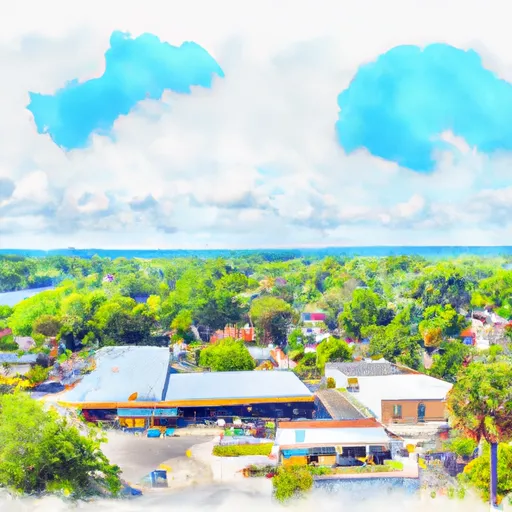-
 Snoflo Premium
Snoflo Premium
Get unlimited access to all our content
With no Ad interruptions! - Start Your Free Trial Login with existing account
Wacissa
Eden Index
Climate
7.4
•
Recreation
3.8
•
Community
•
Safeguard
4.3/10

Wacissa is a small town located in Jefferson County, Florida, known for its natural beauty and outdoor recreational opportunities. The region experiences a humid subtropical climate, characterized by hot and humid summers and mild winters. Average temperatures range from the 60s in winter to the 90s in summer, making it suitable for various outdoor activities year-round.
The town is surrounded by several water bodies, including the Wacissa River, which is a popular destination for kayaking, canoeing, and fishing. The river is home to diverse aquatic flora and fauna and is known for its crystal-clear springs, such as the famous "Big Blue Spring." Visitors can enjoy snorkeling, swimming, and picnicking in the picturesque surroundings.
Wacissa is also part of the Aucilla Wildlife Management Area, providing additional outdoor recreational opportunities. The area offers hiking trails, birdwatching, hunting, and wildlife observation. Visitors can explore the diverse ecosystems, including swamps, marshes, and hardwood forests, while spotting various species of birds, mammals, and reptiles.
In summary, Wacissa, Florida, offers a pleasant climate, pristine waterways, and abundant outdoor recreational opportunities, making it an ideal destination for nature lovers and outdoor enthusiasts.
What is the Eden Index?
The Snoflo Eden Index serves as a comprehensive rating system for regions, evaluating their desirability through a holistic assessment of climate health, outdoor recreation opportunities, and natural disaster risk, acknowledging the profound impact of these factors on livability and well-being.
Climate Health Indicator (CHI): 7.4
Wacissa receives approximately
1492mm of rain per year,
with humidity levels near 88%
and air temperatures averaging around
20°C.
Wacissa has a plant hardyness factor of
8, meaning
plants and agriculture in this region tend to thrive here all year round.
By considering the ideal temperature range, reliable water supplies, clean air, and stable seasonal rain or snowpacks, the Climate Health Indicator (CHI) underscores the significance of a healthy climate as the foundation for quality living.
A healthy climate is paramount for ensuring a high quality of life and livability in a region, fostering both physical well-being and environmental harmony. This can be characterized by ideal temperatures, reliable access to water supplies, clean air, and consistent seasonal rain or snowpacks.
Weather Forecast
Streamflow Conditions
Aucilla-Waccasassa
Area Rivers
Aucilla-Waccasassa
Snowpack Depths
Aucilla-Waccasassa
Reservoir Storage Capacity
Aucilla-Waccasassa
Groundwater Levels
Recreational Opportunity Index (ROI): 3.8
The Recreational Opportunity Index (ROI) recognizes the value of outdoor recreational options, such as parks, hiking trails, camping sites, and fishing spots, while acknowledging that climate plays a pivotal role in ensuring the comfort and consistency of these experiences.
Access to outdoor recreational opportunities, encompassing activities such as parks, hiking, camping, and fishing, is crucial for overall well-being, and the climate plays a pivotal role in enabling and enhancing these experiences, ensuring that individuals can engage in nature-based activities comfortably and consistently.
Camping Areas
| Campground | Campsites | Reservations | Toilets | Showers | Elevation |
|---|---|---|---|---|---|
| Whitewater Creek County Park | 48 | 293 ft | |||
| Andersonville City Campground | 25 | 350 ft | |||
| Georgia Veterans State Park | None | 273 ft | |||
| Newport County Park | 13 | 10 ft | |||
| Parks at Chehaw | 50 | 201 ft | |||
| Marine Albany RV Military | None | 252 ft |
Catastrophe Safeguard Index (CSI):
The Catastrophe Safeguard Index (CSI) recognizes that natural disaster risk, encompassing floods, fires, hurricanes, and tornadoes, can drastically affect safety and the overall appeal of an area.
The level of natural disaster risk in a region significantly affects safety and the overall livability, with climate change amplifying these risks by potentially increasing the frequency and intensity of events like floods, fires, hurricanes, and tornadoes, thereby posing substantial challenges to community resilience and well-being.
Community Resilience Indicator (CRI):
The Community Resilience Indicator (CRI) recognizes that education, healthcare, and socioeconomics are crucial to the well-being of a region. The CRI acknowledges the profound impact of these elements on residents' overall quality of life. By evaluating educational resources, healthcare accessibility, and economic inclusivity, the index captures the essential aspects that contribute to a thriving community, fostering resident satisfaction, equity, and social cohesion.

